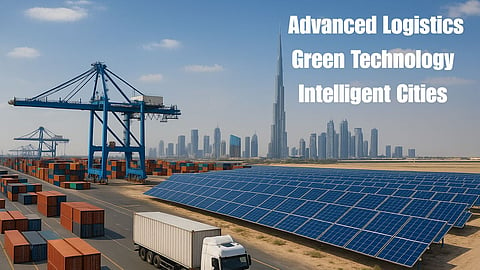Building Tomorrow: How the UAE’s Smart Infrastructure is Reshaping its Economy
The United Arab Emirates (UAE) is in the middle of a structural economic shift. Once defined by oil, the country is now re-engineering itself around three powerful growth engines: advanced logistics infrastructure, sustainable development, and smart cities.
These aren’t separate tracks, they are interlocking investments that are reshaping how the UAE works, trades, and grows.
A Logistics Powerhouse in Motion
For years, the UAE has understood that logistics is more than transport - it’s the backbone of a modern, diversified economy. With its network of ports, airports, free zones, and planned rail corridors, the country positioned itself as a global hub connecting East and West. That foundation is now being expanded and modernized at record speed.
The UAE Logistics Integration Council projects the logistics industry’s contribution to GDP will rise from US$37 billion in 2024 to US$54 billion within seven years.
How the Arabian Peninsula Became Global Trade's Beating Heart
On the ground, that ambition is taking shape through a lattice of ports, rail lines and industrial zones. Dubai’s Jebel Ali Free Zone, one of the world’s busiest, has been upgraded with blockchain-based customs systems and digital cargo tracking.
In Abu Dhabi, Khalifa Economic Zones (KEZAD) is fusing maritime, road, and air logistics into a single platform designed to cut turnaround times for manufacturers. The Etihad Rail project - a US$11 billion national railway - will eventually link the country’s major ports, connecting the Arabian Gulf to the border with Saudi Arabia.
These investments are already lifting trade volumes. The Ministry of Economy reported that non-oil trade reached about US$817 billion in 2024, a 14.6% jump from the previous year. Abu Dhabi’s sovereign wealth fund ADQ underscored the trend in March 2025 when it took a majority stake in logistics giant Aramex, a move to consolidate the UAE’s supply-chain assets and project economic influence along new trade routes into Africa and South Asia.
Smart Cities: The Human Side of Infrastructure
If logistics is the backbone of the new economy, smart cities are its visible face. Across the emirates, billions are flowing into digital infrastructure, clean transport and climate-resilient urban design.
In Dubai, an US$8.2 billion storm-water and drainage project will increase system capacity by 700% - a major adaptation to the heavy rains that hit the city in 2024. The initiative is part of a broader plan to climate-proof the metropolis as temperatures and rainfall patterns grow more erratic.
Abu Dhabi’s Masdar City, once dismissed as a costly green experiment, is now a functioning cleantech cluster housing renewable-energy firms, data centres and research institutions. The capital is also piloting energy-efficient housing districts powered by solar micro-grids and intelligent water systems.
Meanwhile, national regulators are preparing for a new era of transport. In February 2025, the UAE had begun mapping aerial corridors for air taxis and cargo drones, signalling that autonomous air mobility may soon move from demonstration to deployment.
According to a report by Estonia’s Ministry of Economic Affairs, UAE cities are “rapidly transitioning into interconnected, sustainable metropolises,” driven by investments worth roughly US$27 billion in smart infrastructure and intelligent transport.
The Combined Effect: Transforming the Economic Landscape
The results are visible in the macro numbers. Non-oil sectors now account for more than 70% of GDP, up from just over half a decade ago. Manufacturing, trade, logistics and tech-enabled services are expanding rapidly.
The UAE’s Ministry of Economy attributes much of this to the infrastructure surge, which has drawn hundreds of multinationals to base regional headquarters in Dubai and Abu Dhabi.
“The UAE’s model is no longer extractive, it’s connective,” says Nasser Saidi, a Dubai-based economist and former central banker, in a recent policy briefing. “It’s building the networks that move goods, data and people, which is where modern value now lies.”
These networks are also deepening trade ties. Bilateral non-oil trade between India and the UAE is expected to reach US$100 billion by 2030, aided by the new logistics corridors and the Comprehensive Economic Partnership Agreement signed between the two nations.
The Post-Oil Blueprint
Challenges remain: project execution, skills shortages, and the sheer cost of maintaining advanced infrastructure in a desert climate. But diversification has given the federation a buffer that few other oil economies enjoy.
Over the next decade, the UAE is expected to extend its rail and logistics networks, deepen the integration between ports and airports, and roll out more smart-mobility initiatives like drone deliveries and autonomous transport. It will also continue embedding sustainability into every aspect of policy, regulation, and design - turning green infrastructure from an initiative into a national norm.
The transformation underway is not about cosmetic modernization; it’s about long-term competitiveness. By linking logistics, sustainable infrastructure, and smart cities, the UAE is engineering an economy built for resilience, innovation, and global relevance.
The result is a nation steadily redefining what economic growth looks like in the post-oil era - efficient, connected, and sustainable.
Read More: Connected Competition - Inside a New Era of Collaborative Logistics


